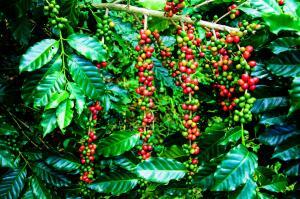
Nuclear Science and Your Java
Most of us can’t live without our morning cup of java. According to the International Coffee Organization (ICO), almost 9 million bags of coffee are exported globally every month. Our caffeine addiction is rising at a growth rate of just under 2 per cent annually; making our morning pick me up big business.
But a disease known as coffee leaf rust could take the zap out of your coffee cup. Coffee leaf rust or Hemileia Vastatrix is a fungus that attacks the leaves of coffee crops. First documented in the late 1800s, coffee leaf rust can cause enormous economic damage to coffee production. As has been widely reported, Sri Lanka was forced to give up coffee production thanks to a damaging outbreak of coffee leaf rust in the 1860s.

Credit: Krutar/Shutterstock
In 2013, Guatemala was one in a series of countries to declare a national agriculture emergency following an outbreak of the organism which destroyed about 70 per cent of coffee crops in the area. The impacts of this disease are profound. Over the last four years, countries in Latin America and the Caribbean have lost approximately one billion dollars in revenue.
The coffee leaf rust organism works by attacking the leaves on coffee plants, leaving behind a yellow-orange coloured looking lesion or spot on the bottom of the leaf. These rust-like lesions reduce a plants ability to conduct photosynthesis, the process by which plants convert sunlight and water to produce oxygen, sugar and carbon dioxide. Reducing photosynthesis, or a plants ability to feed itself, results in lower coffee yields thanks to smaller berry and vegetative growth. Long term impacts of the infection include death of the shoots and roots of the plants, thereby reducing the amount of coffee production overall.
Nuclear science is fighting back against coffee leaf rust.
The International Atomic Energy Agency (IAEA), in conjunction with the Food and Agriculture Organization of the United Nations (FAO) and other partners are hoping for a nuclear solution. They are attempting to breed plants that are resistant to the deadly fungus. A team of experts gathered in early October with the goal of producing resistant coffee plants through a nuclear technique called plant mutation breeding.
Plant mutation breeding works like this. Small doses of radiation are used to alter the DNA or genetic make-up of a plant, making them more resilient to disease and pests such as coffee leaf rust.
“Plant mutation breeding is a fast way to develop improved crops with new and useful traits,” said Stephan Nielen, FAO/IAEA geneticist in charge of the training. “The method also offers a widely accepted, economical and environmentally sustainable approach to protect yield and ensure adequate quantities of pesticide-free crops.”
The work being done in the labs is critical. Climate change is already taking its toll in coffee producing areas. More heat and rainfall has equaled larger outbreaks of pests and diseases like coffee leaf rust, threatening the livelihood of an estimated 120 million people, often the world’s poorest, who rely on coffee income. An increase in temperatures and precipitation has provided a perfect breeding ground for this deadly disease. The problem has become so severe that in 2010, countries teamed up to form an initiative coffee and climate, a response to climate change and its impacts on the coffee industry. They are looking to help more than 70,000 farmers respond to climate change.
The work being done in labs with the IAEA will also provide another tool for the coffee industry, providing more genetically diverse, resistant plants, helping the environment and those who rely on it for their livelihood.



